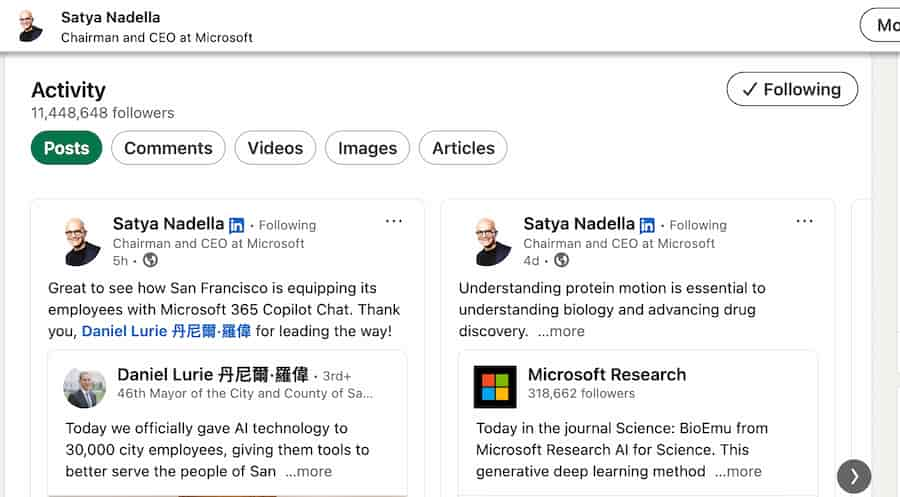The Ultimate Guide to Corporate and Executive Reputation
Managing reputation, both individually as a leader and as a corporation, isn’t just about avoiding negative headlines. It’s also about proactively shaping the narrative around who you are, what you stand for, and what you’re working toward. This isn’t just “image”—it’s about trust. Employees, investors, customers—all stakeholders—rely on your credibility and consistency.
But we get it; actively managing your corporate and executive reputation isn’t simple. You’re juggling investor expectations, public opinion, internal morale, and constant digital scrutiny, all while focusing on running and growing your business. It can feel like a never-ending, exhausting exercise in damage control.
That’s why this guide goes beyond surface-level suggestions. We’re going to unpack what corporate and executive reputation really means, why it matters, and how you can practically build, sustain, and protect it. Whether you’re navigating a CEO-specific challenge, aiming to boost the credibility of your board, or simply focusing on enhancing stakeholder confidence, we’ll outline clear, actionable steps to help you manage reputation effectively.
Because being a successful leader isn’t just about your skills or the numbers—it’s about making sure key stakeholders actually understand and believe in who you are and the value you bring.
TL;DR
- Reputation is proactive, not just reactive. Don’t wait until a challenge emerges—craft your narrative early. If you aren’t shaping your public image, somebody else will do it for you, and you probably won’t like the results.
- Your leadership impacts everyone connected to the business. How you are perceived influences trust from employees, customers, and investors alike. Reputation management isn’t an optional PR exercise; it’s foundational to your effectiveness.
- Social media is an amplifier—good or bad. Used well, it humanizes leaders and connects you with stakeholders. Used carelessly, it magnifies mistakes and reputation missteps fast.
- Boards can’t stay behind closed doors anymore. Strong, transparent board leadership reassures investors and sets a lasting positive tone for governance and accountability.
- Trust requires consistency and patience. A single good quarter or positive news story won’t offset long-term reputation problems. Sustainable trust comes from steady, ethical behavior—and it’s easy to damage if you slip up.
- Preparation matters just as much as response in reputation management. Knowing what steps to take during a crisis and who to involve can save you valuable time and mitigate potential fallout.
- Measure what matters to stay ahead: From sentiment analysis and employee feedback to media insights, tracking the right indicators provides clarity and opportunities for continuous improvement.
Let’s dive in.
Effective Reputation Management for Leaders and Founders
Definition and Core Concepts
Reputation at the individual leadership level is all about consistent, authentic actions and communications that shape how others perceive you. It isn’t just popularity or visibility—it’s how well your stakeholders trust your character and decisions.
Consider Satya Nadella at Microsoft. When he became CEO, he reshaped the company’s internal culture around empathy, continuous learning, and openness. His authentic expression of these values—and his consistency over time—reinvigorated Microsoft’s reputation and elevated his credibility as a leader.

Specific Challenges Leaders Face
Leaders know they operate under constant scrutiny. Even small actions or decisions can suddenly become front-page news—or viral social media moments. One incident sticks out: back in 2017, after United Airlines forcibly removed a passenger from an overbooked flight, the company’s initial defensive response turned a bad incident into a full-blown reputational crisis—exactly what happens when leaders underestimate how quickly reputation can turn.
Internally, executives set the tone for organizational culture. Take Elon Musk and Twitter. Musk’s management style, particularly handling employee layoffs and openly criticizing former team members, has drawn persistent criticism. Internal culture issues often land squarely on leadership’s shoulders and frequently spill into broader public conversations, impacting reputation further.
Proven Methods for Mitigating Leadership-Based Reputation Risks
Addressing these challenges means leaning into transparency, long-term preparation, and authentic positioning. When Johnson & Johnson confronted the Tylenol contamination in the 1980s, CEO James Burke set the standard for reputation crisis response. He acted quickly, transparently, and prioritized consumers first, ultimately restoring public trust.
Proactively developing your public presence through educational content and thought leadership also pays off. Platforms like LinkedIn or even podcasts let you communicate directly with audiences, ensuring your voice is heard clearly and consistently. Take Patagonia CEO Ryan Gellert, for example. He uses LinkedIn to amplify the messaging of causes he believes in, like environmental issues.

But perhaps most importantly, successful leaders actively seek honest feedback—through employee surveys, stakeholder interviews, or social listening. Accepting insights with openness and responding genuinely to feedback helps avoid small issues becoming public debacles.
Mastering CEO Reputation Management
Unique Reputation Challenges for CEOs
When you’re CEO, your personal reputation is inseparable from your company’s credibility. Elon Musk, again, comes to mind: a CEO with exceptional capability—but whose offhand tweets alone have moved stock prices. CEOs must understand just how closely stakeholders tie personal reputation to organizational value.
Role of Social Media in CEO Reputation
Social platforms offer great benefits for a CEO’s communication—but carry significant risks. Satya Nadella successfully leverages LinkedIn to share insights and announce company milestones authentically, reinforcing a positive, consistent profile.
Yet, social media mishaps are common. One tech CEO lost considerable goodwill after tweets ting insensitively about layoffs. CEOs should view digital engagement not just as opportunity, but as a practice requiring discipline and consistency.
One all-too-common mistake when using social media as a reputational tool is to lean too heavily on the marketing/public relations aspect of it. A 2017 study found that companies that treat social media as a purely promotional tool often miss the mark because they lack integration with other business aspects. Focusing too heavily on marketing or public relations could mean you miss out on an integrated strategy that could effectively build and protect your online reputation.
When social media is managed incorrectly, it can lead to:
- Inconsistent messaging: If multiple people in different departments all have access to your company’s social media accounts, it can lead to conflicting messaging that confuses people, which can damage trust.
- Slow crisis response: Your public perception is dependent on the strength and stability of your internal communication. If your company is able to respond quickly and transparently to reputational crises, you can mitigate potential issues before they even arise.
- Poor customer engagement: Treating social media as only a promotional channel ignores its potential for direct customer engagement and relationship-building. This can lead to missed opportunities for deepening relationships with consumers and building a stronger, more resilient reputation
Actionable Steps for CEOs
Here are several practical actions CEOs can take to enhance their personal reputation:
- Develop a clear personal brand positioning, aligning closely with your company’s values.
- Engage authentically on key platforms, avoiding divisive or off-topic posts.
- Consistently communicate transparently during business challenges, maintaining stakeholder trust.
- Regularly share meaningful thought leadership content on relevant industry issues.
- Seek expert counsel or training, particularly for media interactions or crisis scenarios.
Managing Board-Level Reputation
Importance of a Strong Board Reputation
An accountable, open, and respected board is critical—not just behind closed doors, but publicly, too. Poorly managed boards exacerbate issues, as demonstrated by Boeing. Their slow reaction to the 737 Max crisis harmed trust and caused lasting damage.
Strategies for Maintaining Transparency and Accountability
Boards should clearly and proactively communicate their decisions—especially around compensation, governance, and ethics. Unilever does this well by reporting openly on sustainability milestones, demonstrating genuine strategic intent.
Engaging stakeholders—investors, employees, even activists—regularly and directly can also build lasting credibility.
Case Studies in Board Reputation Success
Salesforce’s board openly champions corporate responsibility, strategically aligning company values with board actions. As a result, they consistently build positive credibility with stakeholders across the board.
Strategies to Boost Investor Confidence and Public Trust
Connecting Reputation and Investor Confidence
Leaders know reputation deeply impacts investor decisions. Tesla stock price volatility is often aligned closely with perceptions around Musk’s leadership actions. Clear, honest communication around business decisions is crucial to keep investors comfortable in turbulent waters.
Sustaining Trust Publicly
Brands that effectively demonstrate responsible action and accountability earn an enduring public trust. Starbucks responded quickly—and publicly—after their 2018 racial bias incident. They owned the issue, took visible corrective actions, and maintained their reputation as ethically committed.
Clear Communication Techniques
Clearly and regularly communicating your actions builds stakeholder trust. Share your story often, honestly, and simply—focused on clear sector insights for investors, and positive impact stories for the public.
Tools and Resources for Reputation Management
Top Monitoring Tools
Leaders should leverage reputation-tracking platforms like Brandwatch, Meltwater, or Talkwalker to monitor sentiment and trends in real time, responding quickly and decisively when needed.
Best Practices in Crisis Management
Proactively prepare by running detailed crisis scenario simulations. Tools like Polpeo can help your team prepare realistically in advance, improving actual crisis responses later.
Partnering with Experts
Don’t hesitate to bring in external reputation management advisors for challenging situations. Uber’s reputation recovery in 2017 was accelerated and strengthened with external expertise.
Measuring the Impact of Reputation Efforts
Key Metrics to Track
Monitor indicators like Net Promoter Score, share of voice, sentiment analysis, employee satisfaction, and stakeholder feedback regularly and practically.

(source: https://medium.com/trustfuel/understanding-net-promoter-score-6f6ca862064f)
Leveraging Feedback Loops
Don’t just collect data—use it actively to iteratively improve. If employee engagement dips, be swift and intentional with targeted responses. Regular feedback loops offer continuous improvement opportunities.
Conclusion
Effective reputation management ultimately rests on clarity, authenticity, and a steady hand. It’s about showing your stakeholders exactly who you are and sticking to it consistently over time. Reputation isn’t something you simply manage when things go wrong—it’s something you build proactively while things go right.
Your stakeholders—investors, customers, employees—are watching, listening, and remembering. Make sure the story they see and tell about you is exactly the one you choose.
